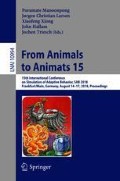Abstract
Cursorial quadrupeds exploit their limbs and bodies (i.e., body–limb coordination) to achieve faster locomotion speed when compared to that with only limbs. Extant studies examined various legged robots that utilize flexible spine bending. However, the control principle of body–limb coordination is not established to date. This study proposes a novel control scheme for body–limb coordination in which all degrees of freedom of the entire body aid each other in achieving higher performance. The 2D simulation results indicate that mutual sensory feedback between the limb and spine plays essential roles in generating their adaptive locomotion patterns in response to physical situations of the body parts and thereby in achieving faster locomotion speeds.
Access this chapter
Tax calculation will be finalised at checkout
Purchases are for personal use only
References
Bertram, J.E., Gutmann, A.: Motions of the running horse and cheetah revisited: fundamental mechanics of the transverse and rotary gallop. J. Roy. Soc. 6, 549–559 (2008)
Maes, L.D., Herbin, M., Hackert, R., Bels, V.L., Abourachid, A.: Steady locomotion in dogs: temporal and associated spatial coordination patterns and the effect of speed. J. Exp. Biol. 211, 138–149 (2008)
Biancardi, C.M., Minetti, A.E.: Biomechanical determinants of transverse and rotary gallop in cursorial mammals. J. Exp. Biol. 215, 4144–4156 (2012)
Schiling, N., Hackert, R.: Sagittal spine movements of small therian mammals during asymmetrical gaits. J. Exp. Biol. 209, 3925–3939 (2006)
Schilling, N., Carrier, D.R.: Function of the epaxial muscles in walking, trotting and galloping dogs: implications for the evolution of epaxial muscle function in tetrapods. J. Exp. Biol. 213, 1490–1502 (2010)
Deng, Q., Wang, S., Xu, W., Mo, J., Liang, Q.: Quasi passive bounding of a quadruped model with articulated spine. Mech. Mach. Theor. 52, 232–242 (2012)
Cao, Q., Poulakakis, I.: Quadrupedal running with a flexible torso: control and speed transitions with sums-of-squares verification. Artif. Life Robot. 21, 384–392 (2016)
Seok, S., Wang, A., Chuah, M.Y., Otten, D., Lang, J., Kim, S.: Design principles for highly efficient quadrupeds and implementation on the MIT cheetah robot. In: Proceedings of IEEE ICRA 2013, pp. 3307–3312 (2013)
Eckert, P., Spröwitz, A., Witte, H., Ijspeert, A.J.: Comparing the effect of different spine and leg designs for a small bounding quadruped robot. In: Proceedings of IEEE ICRA 2015, pp. 3128–3133 (2015)
Pouya, S., Khodabakhsh, M., Spröwitz, A., Ijspeert, A.J.: Spinal joint compliance and actuation in a simulated bounding quadruped robot. Auton. Robot. 41, 437–452 (2017)
Wang, C., Zhang, T., Wei, X., Long, Y., Wang, S.: Dynamic characteristics and stability criterion of rotary galloping gait with an articulated passive spine joint. Ad. Robot. 31(4), 168–183 (2017)
Duperret, J., Koditschek, D.E.: Empirical validation of a spined sagittal-plane quadrupedal model. In: Proceedings of IEEE ICRA 2017, pp. 1058–1064 (2017)
Chen, D., Li, N., Wang, H., Chen, L.: Effect of flexible spine motion on energy efficiency in quadruped running. J. Bionic Eng. 14, 716–725 (2017)
Wang, C., Wang, S.: Bionic control of cheetah bounding with a segmented spine. Appl. Bionics Biomech. 2016, 1–12 (2016). Article No. 5041586
Shura, S., Fukuhara, A., Owaki, D., Kano, T., Ijspeert, A.J., Ishiguro, A.: A minimal model for body-limb coordination in quadruped locomotion. In: The 8th International Symposium on Adaptive Motion of Animals and Machines, p. 39 (2017)
Shura, S., Fukuhara, A., Owaki, D., Kano, T., Ijspeert, A.J., Ishiguro, A.: A simple body-limb coordination model that mimics primitive tetrapod walking. In: Proceedings of the SICE Annual Conference 2017, pp. 12–14 (2017)
Grillner, S.: Locomotion in vertebrates: central mechanisms and reflex interaction. Physiol. Rev. 55(2), 247–304 (1975)
Owaki, D., Kano, T., Nagasawa, K., Tero, A., Ishiguro, A.: Simple robot suggests physical interlimb communication is essential for quadruped walking. J. Roy. Soc. Interface 10(78), 20120669 (2013)
Owaki, D., Ishiguro, A.: A quadruped robot exhibiting spontaneous gait transitions from walking to trotting to galloping. Sci. Rep. 7, 77 (2017). https://doi.org/10.1038/s41598-017-00348-9
Hydson, P.S., Corr, S.A., Davis, R.C., Clancy, S.N., Lane, E., Wilson, A.M.: Functional anatomy of the cheetah (Acinonyx jubatus) forelimb. J. Anat. 218(4), 375–385 (2011)
Acknowledgments
This work was supported by Japan Science and Technology Agency, CREST (JPMJCR14D5).
Author information
Authors and Affiliations
Corresponding author
Editor information
Editors and Affiliations
Rights and permissions
Copyright information
© 2018 Springer Nature Switzerland AG
About this paper
Cite this paper
Fukuhara, A., Koizumi, Y., Suzuki, S., Kano, T., Ishiguro, A. (2018). Minimal Model for Body–Limb Coordination in Quadruped High-Speed Running. In: Manoonpong, P., Larsen, J., Xiong, X., Hallam, J., Triesch, J. (eds) From Animals to Animats 15. SAB 2018. Lecture Notes in Computer Science(), vol 10994. Springer, Cham. https://doi.org/10.1007/978-3-319-97628-0_5
Download citation
DOI: https://doi.org/10.1007/978-3-319-97628-0_5
Published:
Publisher Name: Springer, Cham
Print ISBN: 978-3-319-97627-3
Online ISBN: 978-3-319-97628-0
eBook Packages: Computer ScienceComputer Science (R0)

